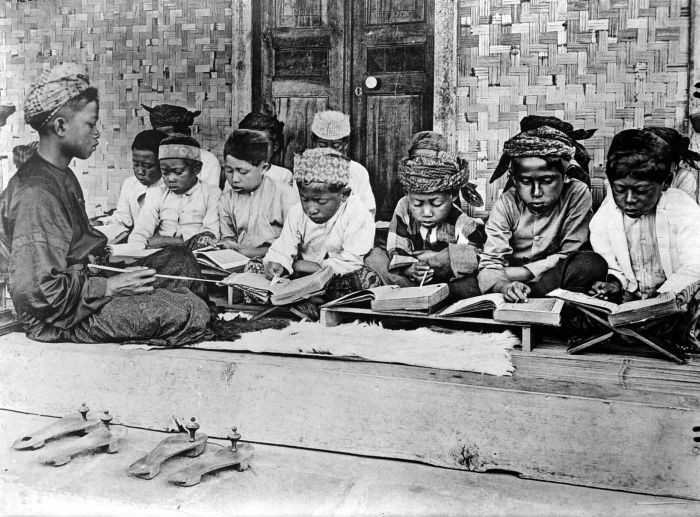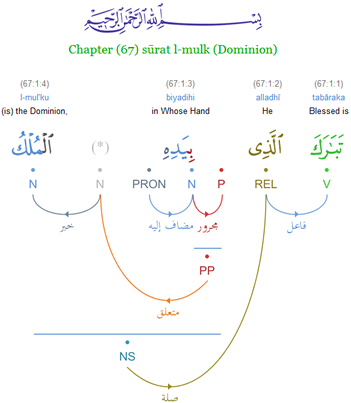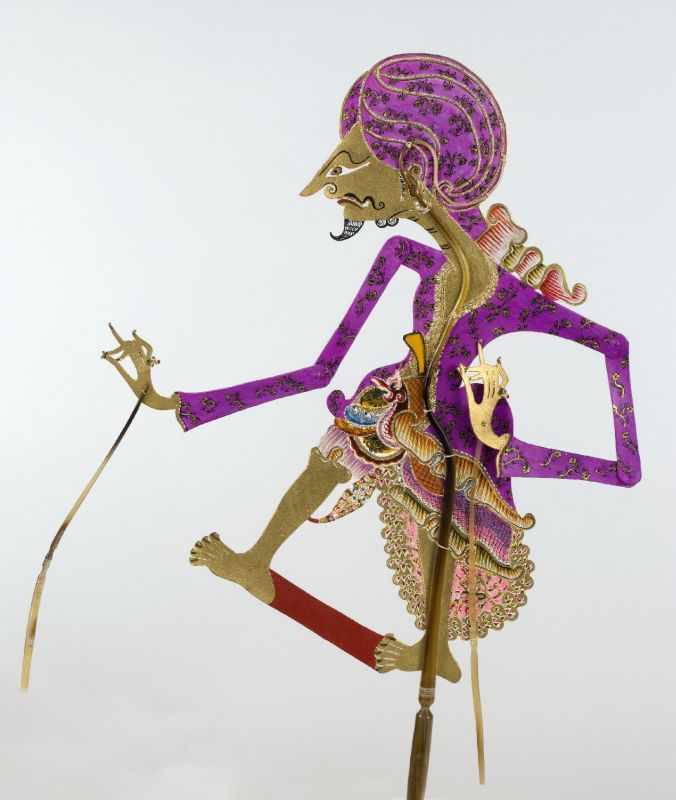|
Kitab Kuning
In Indonesian Islamic education, Kitab kuning (lit: yellow book) refers to the traditional set of the Islamic texts used by the educational curriculum of the Islamic seminary in Indonesia, especially within the madrasahs and pesantrens. Coverage of kitab kuning extends from the principles of Islamic jurisprudence (''usul al-fiqh''), Islamic creeds (''aqidah''), Islamic ethics (''akhlaq''), science of Islamic mysticism (''tasawwuf''), sciences of Arabic language, science of Qur'anic recitations (''tajwid''), hadith studies, tafsir, Qur'anic studies to social sciences. It is also known as ''kitab gundul'' (lit: bare book) due to the content in the Arabic language does not employ vowel marks (''harakat''), unlike the Qur'an. Therefore, mastering of kitab kuning is considered to require a substantial amount of time. Collections of the Islamic texts employed as kitab kuning may vary, depending on the type of institution, individual schools, kyai, and region, with certain prerequisite ma ... [...More Info...] [...Related Items...] OR: [Wikipedia] [Google] [Baidu] |
Pesantren Ramadhan SMA 1 Padang
''Pesantren'', or ''pondok pesantren'', are Islamic boarding schools in Indonesia. They consist of pondok, mosque, santri, teaching of classical Islamic texts and Kyai.Zamakhsyari Dhofie''The Pesantren Tradition: A Study of the Role of the Kyai in the Maintenance of the Traditional Ideology of Islam in Java''Tempe, AZ: Arizona State University Program for Southeast Asian Studies Monograph Series. According to one popular tradition, the ''pesantren'' education system originated from traditional Javanese ''pondokan''; dormitories; ashram for Hindu or viharas for Buddhists to learn religious philosophies, martial arts and meditation. Institutions much like them are found across the Islamic world and are called ''pondok'' in Malaysia and Southern Thailand and '' madrasa Islamia'' (Islamic madrasa) in India and Pakistan and much of the Arabic-speaking world. The ''pesantren'' aim is to deepen knowledge of the Qurʾān, particularly through the study of Arabic, traditions of exegesi ... [...More Info...] [...Related Items...] OR: [Wikipedia] [Google] [Baidu] |
Tafsir
Tafsir ( ar, تفسير, tafsīr ) refers to exegesis, usually of the Quran. An author of a ''tafsir'' is a ' ( ar, مُفسّر; plural: ar, مفسّرون, mufassirūn). A Quranic ''tafsir'' attempts to provide elucidation, explanation, interpretation, context or commentary for clear understanding and conviction of God's will. Principally, a ''tafsir'' deals with the issues of linguistics, jurisprudence, and theology. In terms of perspective and approach, ''tafsir'' can be broadly divided into two main categories, namely ''tafsir bi-al-ma'thur'' (lit. received tafsir), which is transmitted from the early days of Islam through the Islamic prophet Muhammad and his companions, and ''tafsir bi-al-ra'y'' (lit. ''tafsir'' by opinion), which is arrived through personal reflection or independent rational thinking. There are different characteristics and traditions for each of the ''tafsirs'' representing respective schools and doctrines, such as Sunni Islam, Shia Islam, and Suf ... [...More Info...] [...Related Items...] OR: [Wikipedia] [Google] [Baidu] |
Islamic Education In Indonesia
Islam is an Abrahamic monotheistic religion based on the Quran, and the teachings of Muhammad. Adherents of Islam are called Muslims, who are estimated to number 1.9 billion worldwide as of 2020 and are the world's second-largest religious population after Christians. Muslims believe that Islam is the complete and universal version of a primordial faith that was revealed many times through earlier prophets and messengers, including Adam, Noah, Abraham, Moses, and Jesus. Muslims consider the Quran to be the verbatim word of God and the unaltered, final revelation. Alongside the Quran, Muslims also believe in previous revelations, such as the Tawrat (the Torah), the Zabur (Psalms), and the Injil (Gospel). They believe that Muhammad is the main and final of God's prophets, through whom the religion was completed. The teachings and normative examples of Muhammad, called the Sunnah, documented in accounts called the hadith, provide a constitutional model for Muslims. Is ... [...More Info...] [...Related Items...] OR: [Wikipedia] [Google] [Baidu] |
Microsoft Compiled HTML Help
Microsoft Compiled HTML Help is a Microsoft proprietary online help format, consisting of a collection of HTML pages, an index and other navigation tools. The files are compressed and deployed in a binary format with the extension .CHM, for Compiled HTML. The format is often used for software documentation. It was introduced as the successor to Microsoft WinHelp with the release of Windows 95 OSR 2.5 and consequently, Windows 98. Within the Windows NT family, the CHM file support is introduced in Windows NT 4.0 and is still supported in Windows 11. Although the format was designed by Microsoft, it has been successfully reverse-engineered and is now supported in many document viewer applications. History Microsoft has announced that they do not intend to add any new features to HTML Help. File format Help is delivered as a binary file with the .chm extension. It contains a set of HTML files, a hyperlinked table of contents, and an index file. The file format has been ... [...More Info...] [...Related Items...] OR: [Wikipedia] [Google] [Baidu] |
Lignin
Lignin is a class of complex organic polymers that form key structural materials in the support tissues of most plants. Lignins are particularly important in the formation of cell walls, especially in wood and bark, because they lend rigidity and do not rot easily. Chemically, lignins are polymers made by cross-linking phenolic precursors. History Lignin was first mentioned in 1813 by the Swiss botanist A. P. de Candolle, who described it as a fibrous, tasteless material, insoluble in water and alcohol but soluble in weak alkaline solutions, and which can be precipitated from solution using acid. He named the substance “lignine”, which is derived from the Latin word ''lignum'', meaning wood. It is one of the most abundant organic polymers on Earth, exceeded only by cellulose. Lignin constitutes 30% of non-fossil organic carbon on Earth, and 20 to 35% of the dry mass of wood. Lignin is present in red algae, which suggest that the common ancestor of plants and red alga ... [...More Info...] [...Related Items...] OR: [Wikipedia] [Google] [Baidu] |
Santri
In Indonesia, ''santri'' is a term for someone who follows Islamic religious education in '' pesantren'' (Islamic boarding schools). Santri usually stay in the place until their education is complete. After completing their study period, some of them will serve the ''pesantren'' by becoming administrators. According to C.C. Berg, the term "santri" comes from Sanskrit ''shastri'' which means "one who learns Hindu scriptures"; it has the same root as the word ''shastra'' (literature). Starting in 2015, October 22 is designated as the National Santri Day (''Hari Santri Nasional'') in Indonesia. The date refers to "jihad resolution" issued by Hasyim Asy'ari of Nahdlatul Ulama to ulama and santri prior to the national revolution. Geertz research In a study by American sociologist Clifford Geertz, the santri are people, particularly in Java, who practice a more orthodox version of Islam, in contrast to the more syncretic '' abangan''. Geertz identified three main cultural stream ... [...More Info...] [...Related Items...] OR: [Wikipedia] [Google] [Baidu] |
Arabic Grammar
Arabic grammar or Arabic language sciences ( ar, النحو العربي ' or ar, عُلُوم اللغَة العَرَبِيَّة ') is the grammar of the Arabic language. Arabic is a Semitic language and its grammar has many similarities with the grammar of other Semitic languages. Classical Arabic and Modern Standard Arabic have largely the same grammar; colloquial spoken varieties of Arabic can vary in different ways. The largest differences between classical and colloquial Arabic are the loss of morphological markings of grammatical case; changes in word order, an overall shift towards a more analytic morphosyntax, the loss of the previous system of grammatical mood, along with the evolution of a new system; the loss of the inflected passive voice, except in a few relict varieties; restriction in the use of the dual number and (for most varieties) the loss of the feminine plural. Many Arabic dialects, Maghrebi Arabic in particular also have significant vowel shifts a ... [...More Info...] [...Related Items...] OR: [Wikipedia] [Google] [Baidu] |
Rashidun Caliphate
The Rashidun Caliphate ( ar, اَلْخِلَافَةُ ٱلرَّاشِدَةُ, al-Khilāfah ar-Rāšidah) was the first caliphate to succeed the Islamic prophet Muhammad. It was ruled by the first four successive caliphs of Muhammad after his death in 632 CE (11 AH). During its existence, the empire was the most powerful economic, cultural, and military force in West Asia. The caliphate arose following Muhammad’s passing in June 632 and the subsequent debate over the succession to his leadership. Muhammad's childhood friend and close companion Abu Bakr (), of the Banu Taym clan, was elected the first caliph in Medina and he began the conquest of the Arabian Peninsula. His brief reign ended in August 634 when he died and was succeeded by Umar (), his appointed successor from the Banu Adi clan. Under Umar, the caliphate expanded at an unprecedented rate, ruling more than two-thirds of the Byzantine Empire and nearly the entire Sasanian Empire. Umar was assassinated in ... [...More Info...] [...Related Items...] OR: [Wikipedia] [Google] [Baidu] |
Tafsir Al-Jalalayn
''Tafsīr al-Jalālayn'' ( ar, تفسير الجلالين, lit=Tafsir of the two Jalals) is a classical Sunni interpretation (tafsir) of the Qur'an, composed first by Jalal ad-Din al-Maḥalli in 1459 and then completed after his passing by Jalal ad-Din as-Suyuti in 1505, thus its name, which means "Tafsir of the two Jalals". It is recognised as one of the most popular exegeses of the Qur'an today,''Tafsir al-Jalalayn'', Altafsir.com accessed 16 March 2014 due to its simple style and its conciseness, as it is only one volume in length. Tafsir al-Jalalayn has been translated into many languages including English, |
Kyai
A kyai ( ) is an expert in Islam, usually used among the ethnic Javanese people. Origins The word is of Javanese origin. Sometimes it is spelled kiai. Traditionally, students of Islam in Indonesia would study in a boarding school known as a pesantren. The leader of the school was called kyai, as a form of respect. The traditional word for a teacher in Islam is ustad, which is a Persian word. There are many ustads in Indonesia who teach the religion, but most of them do not have a boarding school. Education Kiai were educated in various pesantren: A student in a pesantren is called a santri. After the founding kyai of a pesantren dies, his son or another santri may take over the supervision of the school, and would then be called kyai. It is possible for a large boarding school to have several kyai living and teaching there. However, most pesantren have a few hundred students, with only one person who is called kyai. The other teachers in the school are called ustadz. Man ... [...More Info...] [...Related Items...] OR: [Wikipedia] [Google] [Baidu] |
Harakat
The Arabic script has numerous diacritics, which include: consonant pointing known as (), and supplementary diacritics known as (). The latter include the vowel marks termed (; singular: , '). The Arabic script is a modified abjad, where short consonants and long vowels are represented by letters but short vowels and consonant length are not generally indicated in writing. ' is optional to represent missing vowels and consonant length. Modern Arabic is always written with the ''i‘jām''—consonant pointing, but only religious texts, children's books and works for learners are written with the full ''tashkīl''—vowel guides and consonant length. It is however not uncommon for authors to add diacritics to a word or letter when the grammatical case or the meaning is deemed otherwise ambiguous. In addition, classical works and historic documents rendered to the general public are often rendered with the full ''tashkīl'', to compensate for the gap in understanding resultin ... [...More Info...] [...Related Items...] OR: [Wikipedia] [Google] [Baidu] |
Social Science
Social science is one of the branches of science, devoted to the study of societies and the relationships among individuals within those societies. The term was formerly used to refer to the field of sociology, the original "science of society", established in the 19th century. In addition to sociology, it now encompasses a wide array of academic disciplines, including anthropology, archaeology, economics, human geography, linguistics, management science, communication science and political science. Positivist social scientists use methods resembling those of the natural sciences as tools for understanding society, and so define science in its stricter modern sense. Interpretivist social scientists, by contrast, may use social critique or symbolic interpretation rather than constructing empirically falsifiable theories, and thus treat science in its broader sense. In modern academic practice, researchers are often eclectic, using multiple methodologies (for instan ... [...More Info...] [...Related Items...] OR: [Wikipedia] [Google] [Baidu] |









